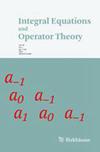具有一般界面条件的自相关耦合的局部谱多重性
IF 0.9
3区 数学
Q2 MATHEMATICS
引用次数: 0
摘要
我们考虑通过将有限数量的边界关系与一维边界空间粘贴而得到的自相关算子。这种算子的一个典型例子是星形图上的薛定谔算子,该星形图具有有限数量的有限或无限边,在公共顶点处有一个界面条件。我们考虑了一大类 "自联合 "界面条件,这些条件一般都满足一个假设。我们根据解耦算子的谱数据确定奇异谱(连续谱和点谱)上的谱多重性函数。本文章由计算机程序翻译,如有差异,请以英文原文为准。
Local Spectral Multiplicity of Selfadjoint Couplings with General Interface Conditions
We consider selfadjoint operators obtained by pasting a finite number of boundary relations with one-dimensional boundary space. A typical example of such an operator is the Schrödinger operator on a star-graph with a finite number of finite or infinite edges and an interface condition at the common vertex. A wide class of “selfadjoint” interface conditions, subject to an assumption which is generically satisfied, is considered. We determine the spectral multiplicity function on the singular spectrum (continuous as well as point) in terms of the spectral data of decoupled operators.
求助全文
通过发布文献求助,成功后即可免费获取论文全文。
去求助
来源期刊
CiteScore
1.60
自引率
0.00%
发文量
36
审稿时长
6 months
期刊介绍:
Integral Equations and Operator Theory (IEOT) is devoted to the publication of current research in integral equations, operator theory and related topics with emphasis on the linear aspects of the theory. The journal reports on the full scope of current developments from abstract theory to numerical methods and applications to analysis, physics, mechanics, engineering and others. The journal consists of two sections: a main section consisting of refereed papers and a second consisting of short announcements of important results, open problems, information, etc.

 求助内容:
求助内容: 应助结果提醒方式:
应助结果提醒方式:


